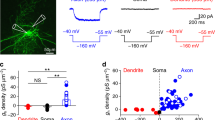Abstract
AFTER repetitive stimulation, the membrane potential of nerve fibres is transiently increased. It has been suggested by Ritchie and Straub1 that this hyperpolarization could be explained on the basis of two assumptions: that the ionic pump responsible for the coupled efflux of sodium ions and influx of potassium ions2 becomes hyperactive following stimulation because of the raised intra-cellular sodium ion concentration3; that the extracellular space adjacent to the membrane is confined by a diffusional barrier. Following activity, the hyperactive pump would deplete the potassium in this space and thus raise the membrane potential of the nerve fibre above its resting level. A consequence of this hypothesis is that, in the absence of extracellular potassium, the sodium pump would be unable to lower the potassium concentration further and there would be no post-tetanic hyperpolarization, as Ritchie and Straub1 indeed found in mammalian C-fibres. On the other hand, an increased post-tetanic hyperpolarization in potassium-free solutions has since been reported both in the same fibres4 and in frog nodes of Ranvier5.
This is a preview of subscription content, access via your institution
Access options
Subscribe to this journal
Receive 51 print issues and online access
$199.00 per year
only $3.90 per issue
Buy this article
- Purchase on Springer Link
- Instant access to full article PDF
Prices may be subject to local taxes which are calculated during checkout
Similar content being viewed by others
References
Ritchie, J. M., and Straub, R. W., J. Physiol., 136, 80 (1957).
Hodgkin, A. L., and Keynes, R. D., J. Physiol., 128, 28 (1955).
Hodgkin, A. L., and Keynes, R. D., J. Physiol., 131, 592 (1956).
Holmes, O., Arch. int. Physiol., 70, 211 (1962).
Meves, H., Pflügers Archiv., 272, 336 (1961).
Hubbard, J. I., and Schmidt, R. F., J. Physiol., 166, 145 (1963).
Wall, P. D., J. Physiol., 142, 1 (1958).
Coombs, J. S., Eccles, J. C., and Fatt, P., J. Physiol., 130, 291 (1955).
Boyle, P. J., and Conway, E. J., J. Physiol., 100, 1 (1941).
Author information
Authors and Affiliations
Rights and permissions
About this article
Cite this article
GAGE, P., HUBBARD, J. Ionic Changes Responsible for Post-tetanic Hyperpolarization. Nature 203, 653–654 (1964). https://doi.org/10.1038/203653a0
Issue Date:
DOI: https://doi.org/10.1038/203653a0
This article is cited by
Comments
By submitting a comment you agree to abide by our Terms and Community Guidelines. If you find something abusive or that does not comply with our terms or guidelines please flag it as inappropriate.



